check engine Hyundai Ioniq Plug-in Hybrid 2020 Manual PDF
[x] Cancel search | Manufacturer: HYUNDAI, Model Year: 2020, Model line: Ioniq Plug-in Hybrid, Model: Hyundai Ioniq Plug-in Hybrid 2020Pages: 635, PDF Size: 52.13 MB
Page 557 of 635
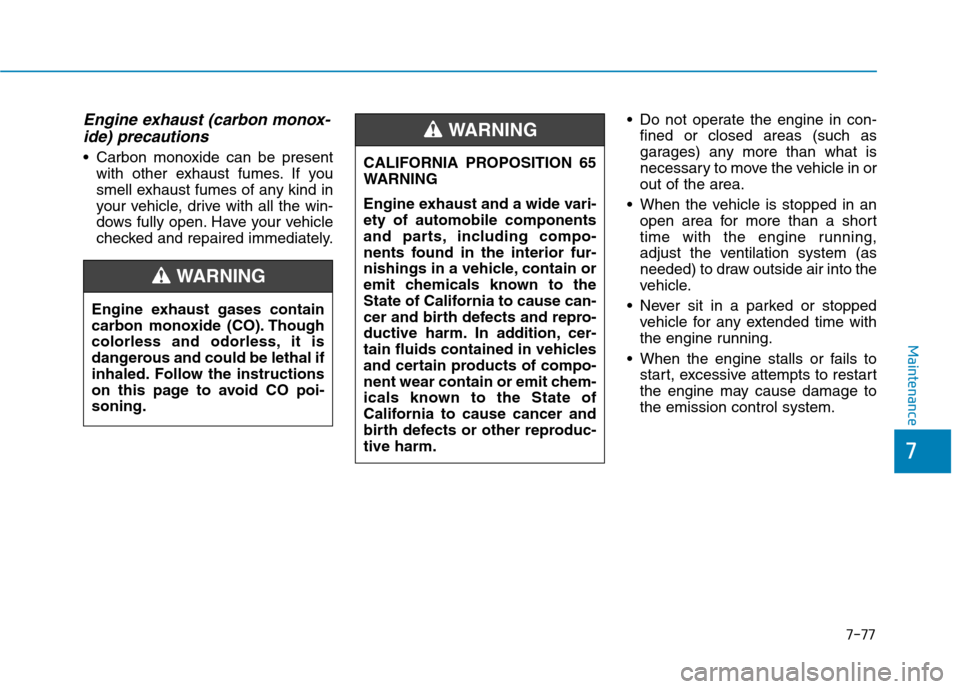
7-77
7
Maintenance
Engine exhaust (carbon monox-
ide) precautions
Carbon monoxide can be present
with other exhaust fumes. If you
smell exhaust fumes of any kind in
your vehicle, drive with all the win-
dows fully open. Have your vehicle
checked and repaired immediately. Do not operate the engine in con-
fined or closed areas (such as
garages) any more than what is
necessary to move the vehicle in or
out of the area.
When the vehicle is stopped in an
open area for more than a short
time with the engine running,
adjust the ventilation system (as
needed) to draw outside air into the
vehicle.
Never sit in a parked or stopped
vehicle for any extended time with
the engine running.
When the engine stalls or fails to
start, excessive attempts to restart
the engine may cause damage to
the emission control system. CALIFORNIA PROPOSITION 65
WARNING
Engine exhaust and a wide vari-
ety of automobile components
and parts, including compo-
nents found in the interior fur-
nishings in a vehicle, contain or
emit chemicals known to the
State of California to cause can-
cer and birth defects and repro-
ductive harm. In addition, cer-
tain fluids contained in vehicles
and certain products of compo-
nent wear contain or emit chem-
icals known to the State of
California to cause cancer and
birth defects or other reproduc-
tive harm.
WARNING
Engine exhaust gases contain
carbon monoxide (CO). Though
colorless and odorless, it is
dangerous and could be lethal if
inhaled. Follow the instructions
on this page to avoid CO poi-
soning.
WARNING
Page 567 of 635
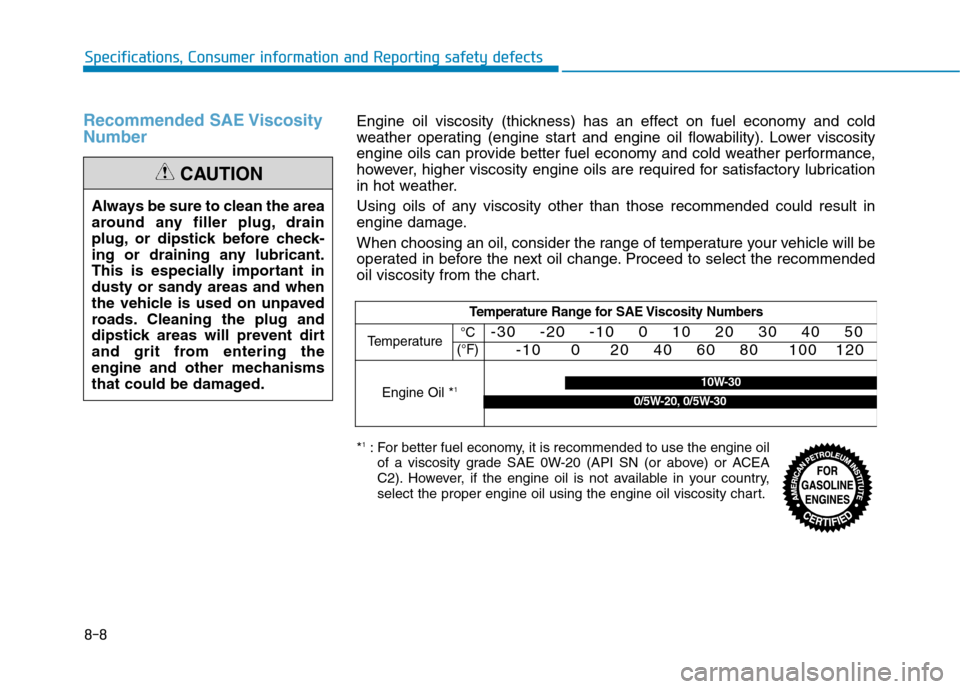
8-8
Specifications, Consumer information and Reporting safety defects
Recommended SAE Viscosity
Number
Always be sure to clean the area
around any filler plug, drain
plug, or dipstick before check-
ing or draining any lubricant.
This is especially important in
dusty or sandy areas and when
the vehicle is used on unpaved
roads. Cleaning the plug and
dipstick areas will prevent dirt
and grit from entering the
engine and other mechanisms
that could be damaged.
CAUTION
Temperature Range for SAE Viscosity Numbers
Temperature -30 -20 -10 0 10 20 30 40 50
-10 0 20 40 60 80 100 120
Engine Oil *1
°C
(°F)
*1: For better fuel economy, it is recommended to use the engine oil
of a viscosity grade SAE 0W-20 (API SN (or above) or ACEA
C2). However, if the engine oil is not available in your country,
select the proper engine oil using the engine oil viscosity chart.
10W-30
0/5W-20, 0/5W-30
Engine oil viscosity (thickness) has an effect on fuel economy and cold
weather operating (engine start and engine oil flowability). Lower viscosity
engine oils can provide better fuel economy and cold weather performance,
however, higher viscosity engine oils are required for satisfactory lubrication
in hot weather.
Using oils of any viscosity other than those recommended could result in
engine damage.
When choosing an oil, consider the range of temperature your vehicle will be
operated in before the next oil change. Proceed to select the recommended
oil viscosity from the chart.
Page 599 of 635
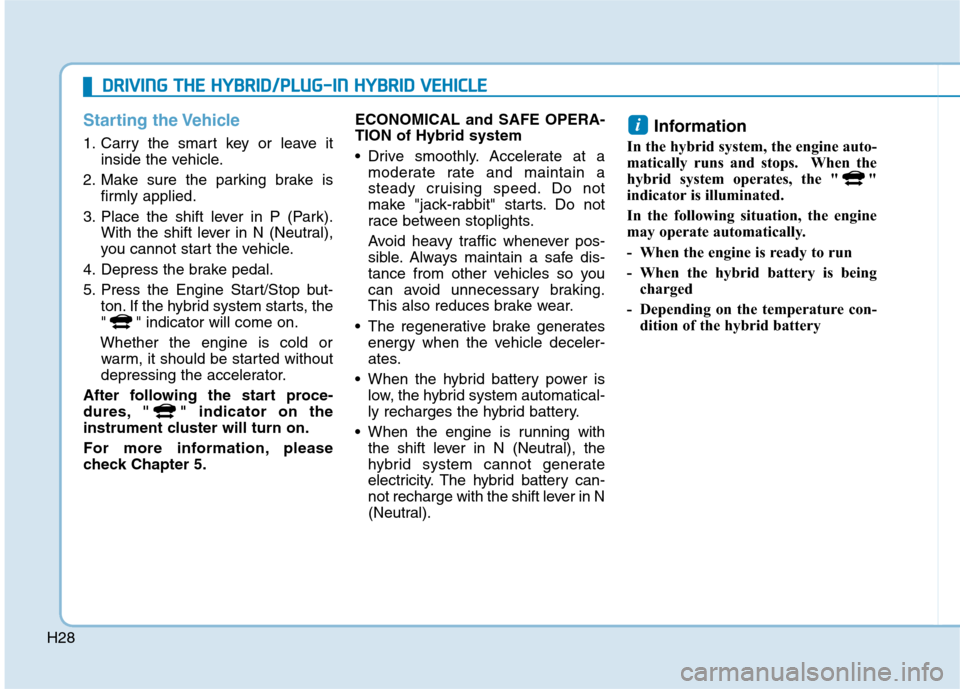
H28
Starting the Vehicle
1. Carry the smart key or leave it
inside the vehicle.
2. Make sure the parking brake is
firmly applied.
3. Place the shift lever in P (Park).
With the shift lever in N (Neutral),
you cannot start the vehicle.
4. Depress the brake pedal.
5. Press the Engine Start/Stop but-
ton. If the hybrid system starts, the
" " indicator will come on.
Whether the engine is cold or
warm, it should be started without
depressing the accelerator.
After following the start proce-
dures, " " indicator on the
instrument cluster will turn on.
For more information, please
check Chapter 5.ECONOMICAL and SAFE OPERA-
TION of Hybrid system
Drive smoothly. Accelerate at a
moderate rate and maintain a
steady cruising speed. Do not
make "jack-rabbit" starts. Do not
race between stoplights.
Avoid heavy traffic whenever pos-
sible. Always maintain a safe dis-
tance from other vehicles so you
can avoid unnecessary braking.
This also reduces brake wear.
The regenerative brake generates
energy when the vehicle deceler-
ates.
When the hybrid battery power is
low, the hybrid system automatical-
ly recharges the hybrid battery.
When the engine is running with
the shift lever in N (Neutral), the
hybrid system cannot generate
electricity. The hybrid battery can-
not recharge with the shift lever in N
(Neutral).
Information
In the hybrid system, the engine auto-
matically runs and stops. When the
hybrid system operates, the " "
indicator is illuminated.
In the following situation, the engine
may operate automatically.
- When the engine is ready to run
- When the hybrid battery is being
charged
- Depending on the temperature con-
dition of the hybrid battery
i
D DR
RI
IV
VI
IN
NG
G
T
TH
HE
E
H
HY
YB
BR
RI
ID
D/
/P
PL
LU
UG
G-
-I
IN
N
H
HY
YB
BR
RI
ID
D
V
VE
EH
HI
IC
CL
LE
E
Page 602 of 635
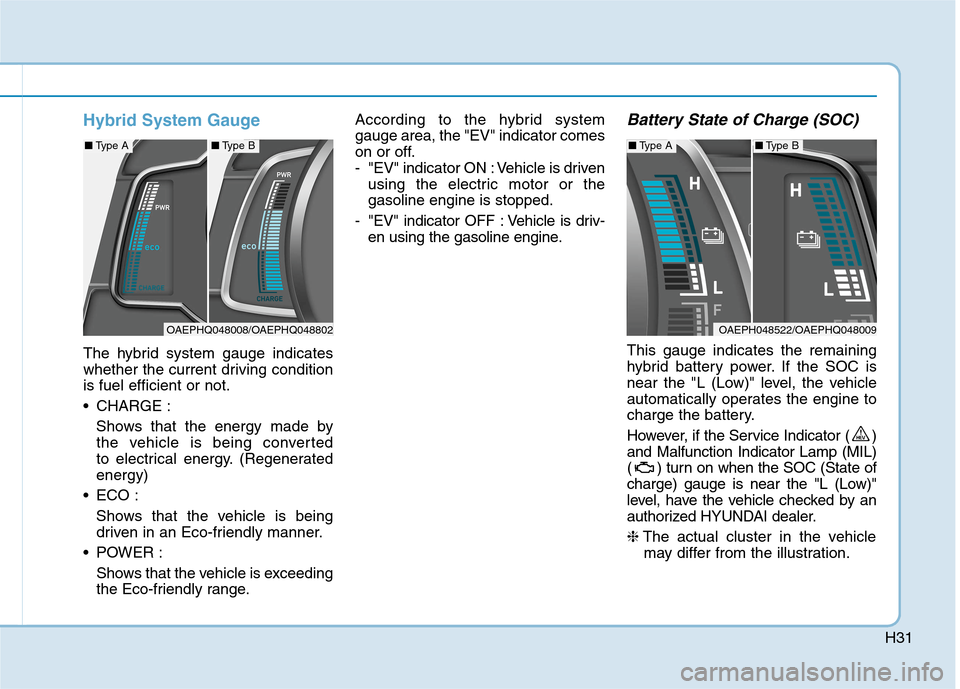
H31
Hybrid System Gauge
The hybrid system gauge indicates
whether the current driving condition
is fuel efficient or not.
CHARGE :
Shows that the energy made by
the vehicle is being converted
to electrical energy. (Regenerated
energy)
ECO :
Shows that the vehicle is being
driven in an Eco-friendly manner.
POWER :
Shows that the vehicle is exceeding
the Eco-friendly range.According to the hybrid system
gauge area, the "EV" indicator comes
on or off.
- "EV" indicator ON : Vehicle is driven
using the electric motor or the
gasoline engine is stopped.
- "EV" indicator OFF : Vehicle is driv-
en using the gasoline engine.
Battery State of Charge (SOC)
This gauge indicates the remaining
hybrid battery power. If the SOC is
near the "L (Low)" level, the vehicle
automatically operates the engine to
charge the battery.
However, if the Service Indicator ( )
and Malfunction Indicator Lamp (MIL)
( ) turn on when the SOC (State of
charge) gauge is near the "L (Low)"
level, have the vehicle checked by an
authorized HYUNDAI dealer.
❈The actual cluster in the vehicle
may differ from the illustration.
OAEPHQ048008/OAEPHQ048802
■Type A■Type B
OAEPH048522/OAEPHQ048009
■Type A■Type B
Page 607 of 635
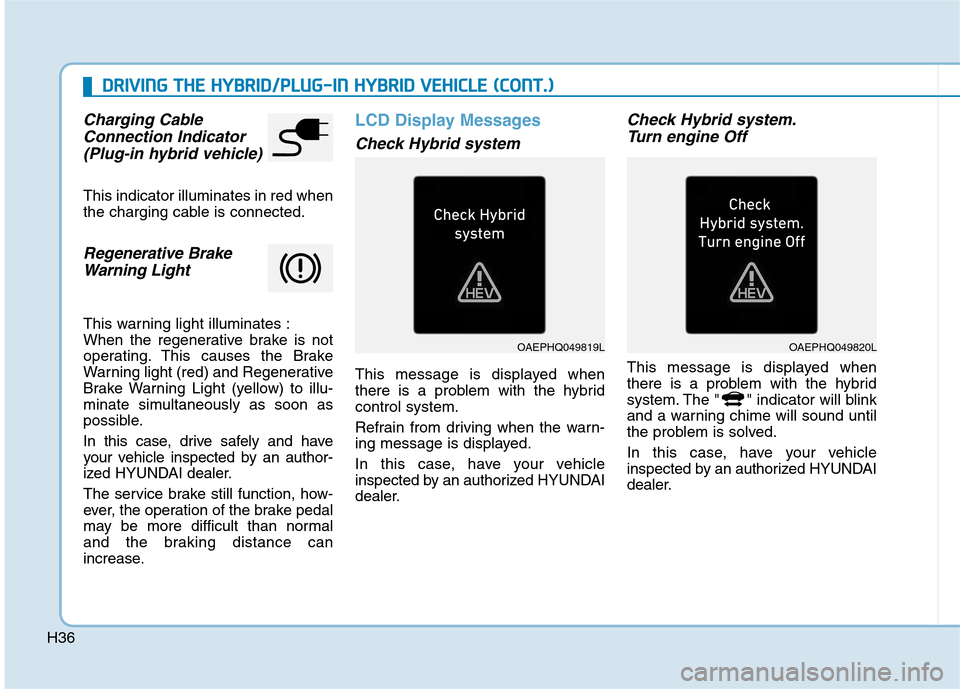
H36
D DR
RI
IV
VI
IN
NG
G
T
TH
HE
E
H
HY
YB
BR
RI
ID
D/
/P
PL
LU
UG
G-
-I
IN
N
H
HY
YB
BR
RI
ID
D
V
VE
EH
HI
IC
CL
LE
E
(
(C
CO
ON
NT
T.
.)
)
Charging Cable
Connection Indicator
(Plug-in hybrid vehicle)
This indicator illuminates in red when
the charging cable is connected.
Regenerative Brake
Warning Light
This warning light illuminates :
When the regenerative brake is not
operating. This causes the Brake
Warning light (red) and Regenerative
Brake Warning Light (yellow) to illu-
minate simultaneously as soon as
possible.
In this case, drive safely and have
your vehicle inspected by an author-
ized HYUNDAI dealer.
The service brake still function, how-
ever, the operation of the brake pedal
may be more difficult than normal
and the braking distance can
increase.
LCD Display Messages
Check Hybrid system
This message is displayed when
there is a problem with the hybrid
control system.
Refrain from driving when the warn-
ing message is displayed.
In this case, have your vehicle
inspected by an authorized HYUNDAI
dealer.
Check Hybrid system.
Turn engine Off
This message is displayed when
there is a problem with the hybrid
system. The " " indicator will blink
and a warning chime will sound until
the problem is solved.
In this case, have your vehicle
inspected by an authorized HYUNDAI
dealer.
OAEPHQ049819LOAEPHQ049820L
Page 608 of 635
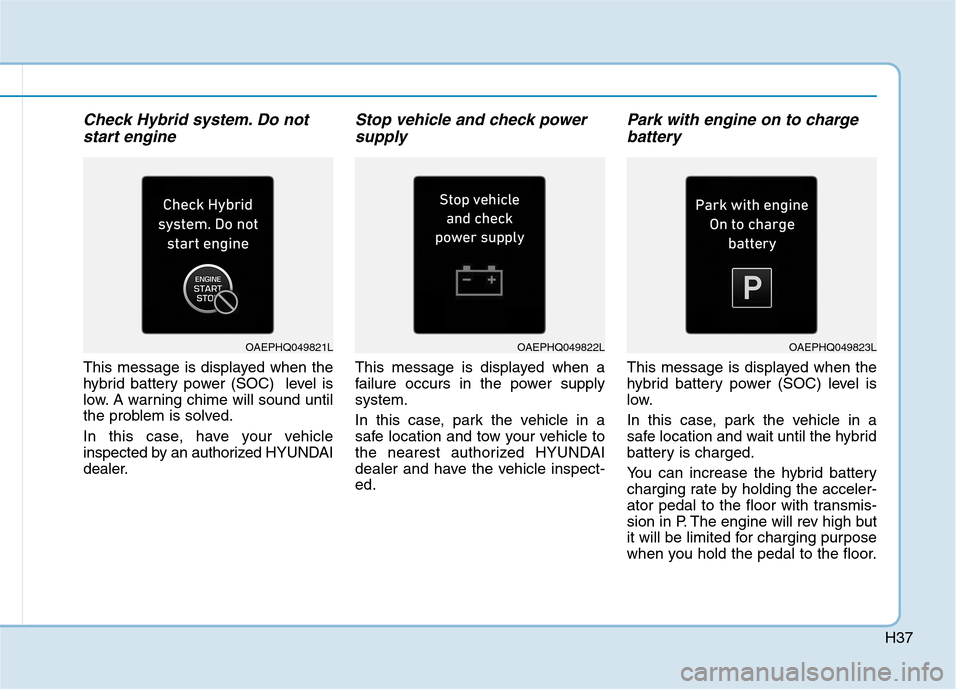
H37
Check Hybrid system. Do not
start engine
This message is displayed when the
hybrid battery power (SOC) level is
low. A warning chime will sound until
the problem is solved.
In this case, have your vehicle
inspected by an authorized HYUNDAI
dealer.
Stop vehicle and check power
supply
This message is displayed when a
failure occurs in the power supply
system.
In this case, park the vehicle in a
safe location and tow your vehicle to
the nearest authorized HYUNDAI
dealer and have the vehicle inspect-
ed.
Park with engine on to charge
battery
This message is displayed when the
hybrid battery power (SOC) level is
low.
In this case, park the vehicle in a
safe location and wait until the hybrid
battery is charged.
You can increase the hybrid battery
charging rate by holding the acceler-
ator pedal to the floor with transmis-
sion in P. The engine will rev high but
it will be limited for charging purpose
when you hold the pedal to the floor.
OAEPHQ049821LOAEPHQ049822LOAEPHQ049823L
Page 610 of 635
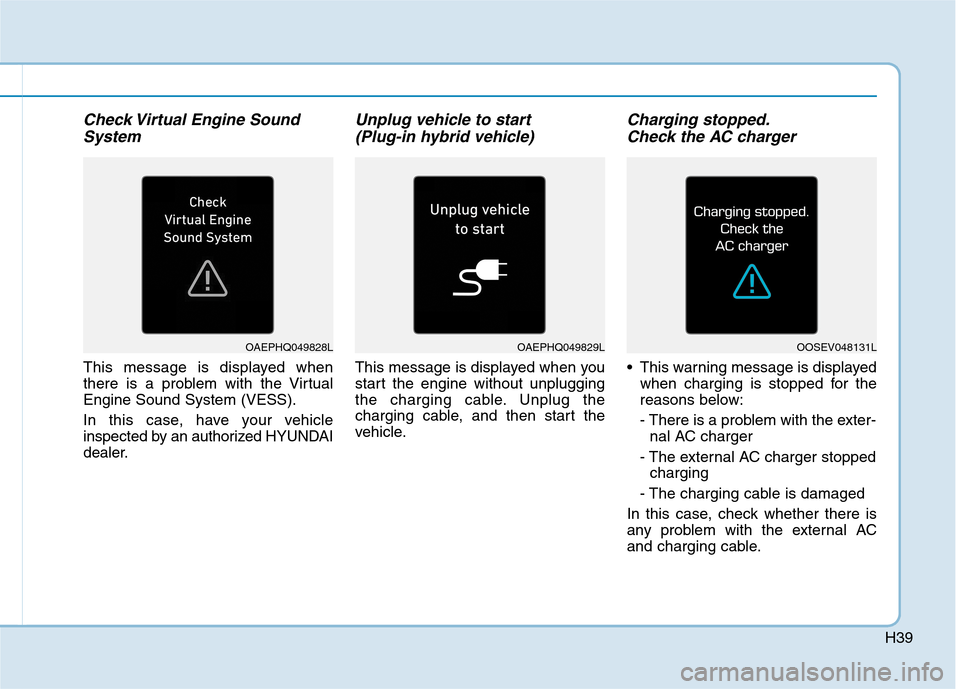
H39
Check Virtual Engine Sound
System
This message is displayed when
there is a problem with the Virtual
Engine Sound System (VESS).
In this case, have your vehicle
inspected by an authorized HYUNDAI
dealer.
Unplug vehicle to start
(Plug-in hybrid vehicle)
This message is displayed when you
start the engine without unplugging
the charging cable. Unplug the
charging cable, and then start the
vehicle.
Charging stopped.
Check the AC charger
This warning message is displayed
when charging is stopped for the
reasons below:
- There is a problem with the exter-
nal AC charger
- The external AC charger stopped
charging
- The charging cable is damaged
In this case, check whether there is
any problem with the external AC
and charging cable.
OAEPHQ049828LOAEPHQ049829LOOSEV048131L
Page 622 of 635
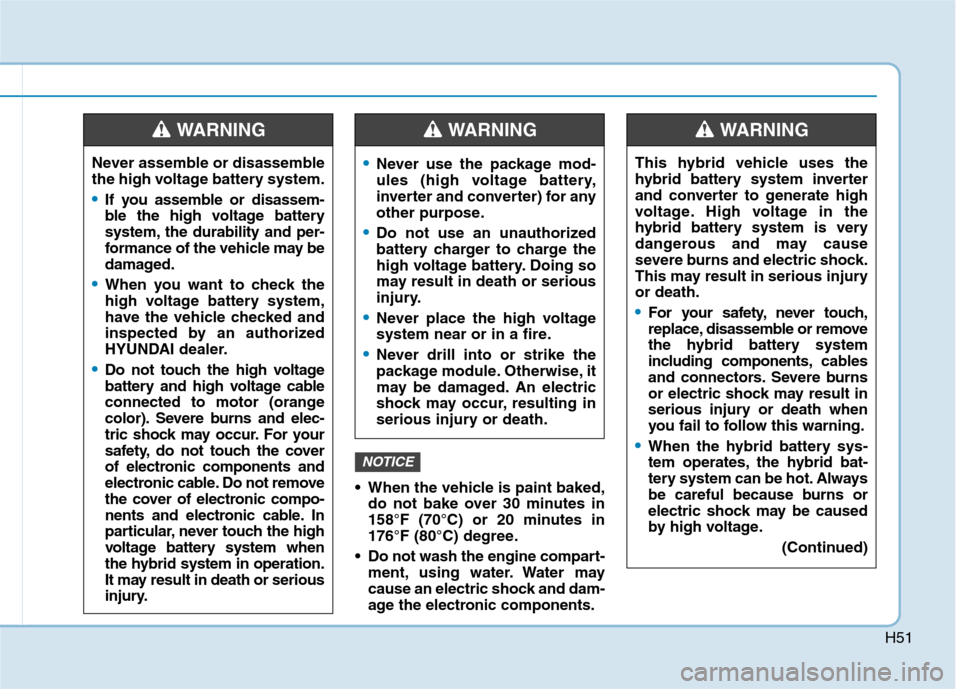
H51
When the vehicle is paint baked,
do not bake over 30 minutes in
158°F (70°C) or 20 minutes in
176°F (80°C) degree.
Do not wash the engine compart-
ment, using water. Water may
cause an electric shock and dam-
age the electronic components.
NOTICE
Never use the package mod-
ules (high voltage battery,
inverter and converter) for any
other purpose.
Do not use an unauthorized
battery charger to charge the
high voltage battery. Doing so
may result in death or serious
injury.
Never place the high voltage
system near or in a fire.
Never drill into or strike the
package module. Otherwise, it
may be damaged. An electric
shock may occur, resulting in
serious injury or death.
WARNING
This hybrid vehicle uses the
hybrid battery system inverter
and converter to generate high
voltage. High voltage in the
hybrid battery system is very
dangerous and may cause
severe burns and electric shock.
This may result in serious injury
or death.
For your safety, never touch,
replace, disassemble or remove
the hybrid battery system
including components, cables
and connectors. Severe burns
or electric shock may result in
serious injury or death when
you fail to follow this warning.
When the hybrid battery sys-
tem operates, the hybrid bat-
tery system can be hot. Always
be careful because burns or
electric shock may be caused
by high voltage.
(Continued)
WARNING
Never assemble or disassemble
the high voltage battery system.
If you assemble or disassem-
ble the high voltage battery
system, the durability and per-
formance of the vehicle may be
damaged.
When you want to check the
high voltage battery system,
have the vehicle checked and
inspected by an authorized
HYUNDAI dealer.
Do not touch the high voltage
battery and high voltage cable
connected to motor (orange
color). Severe burns and elec-
tric shock may occur. For your
safety, do not touch the cover
of electronic components and
electronic cable. Do not remove
the cover of electronic compo-
nents and electronic cable. In
particular, never touch the high
voltage battery system when
the hybrid system in operation.
It may result in death or serious
injury.
WARNING
Page 626 of 635
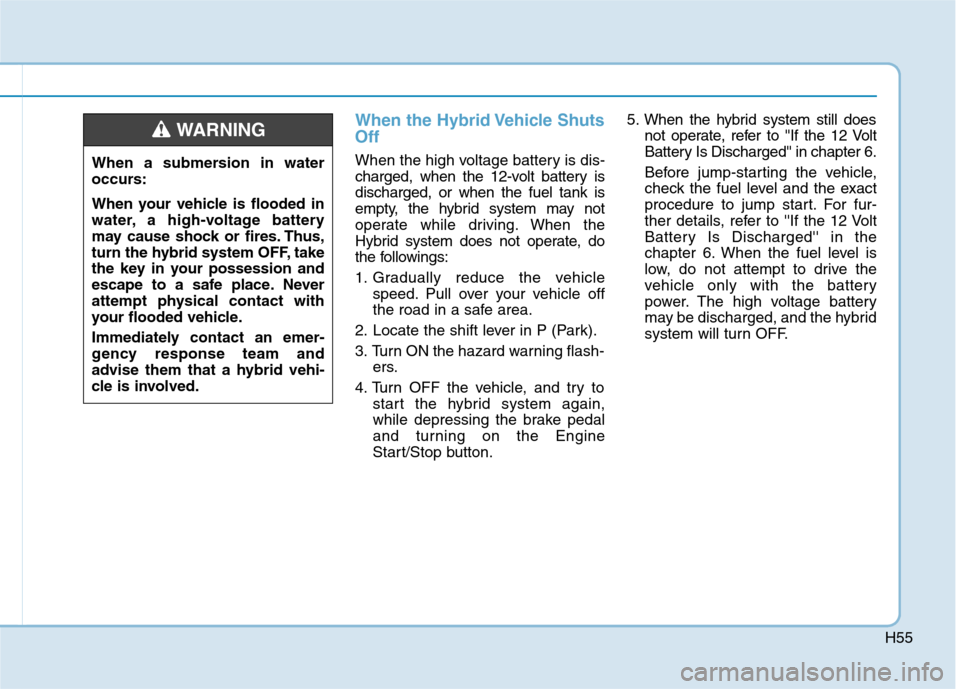
H55
When the Hybrid Vehicle Shuts
Off
When the high voltage battery is dis-
charged, when the 12-volt battery is
discharged, or when the fuel tank is
empty, the hybrid system may not
operate while driving. When the
Hybrid system does not operate, do
the followings:
1. Gradually reduce the vehicle
speed. Pull over your vehicle off
the road in a safe area.
2. Locate the shift lever in P (Park).
3. Turn ON the hazard warning flash-
ers.
4. Turn OFF the vehicle, and try to
start the hybrid system again,
while depressing the brake pedal
and turning on the Engine
Start/Stop button.5. When the hybrid system still does
not operate, refer to ''If the 12 Volt
Battery Is Discharged'' in chapter 6.
Before jump-starting the vehicle,
check the fuel level and the exact
procedure to jump start. For fur-
ther details, refer to ''If the 12 Volt
Battery Is Discharged'' in the
chapter 6. When the fuel level is
low, do not attempt to drive the
vehicle only with the battery
power. The high voltage battery
may be discharged, and the hybrid
system will turn OFF. When a submersion in water
occurs:
When your vehicle is flooded in
water, a high-voltage battery
may cause shock or fires. Thus,
turn the hybrid system OFF, take
the key in your possession and
escape to a safe place. Never
attempt physical contact with
your flooded vehicle.
Immediately contact an emer-
gency response team and
advise them that a hybrid vehi-
cle is involved.
WARNING
Page 629 of 635
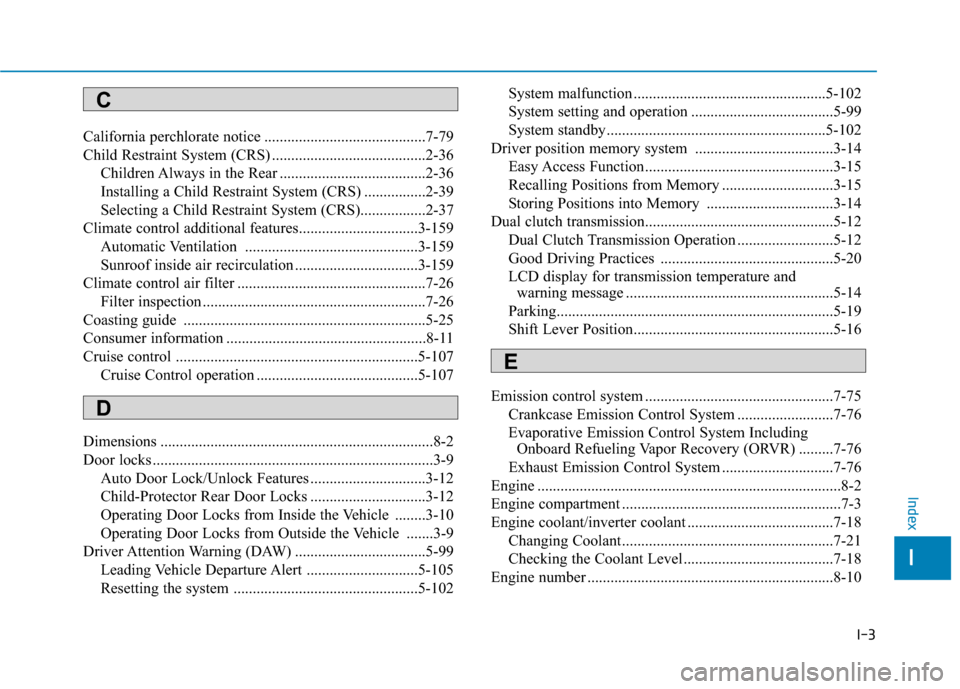
I-3
California perchlorate notice ..........................................7-79
Child Restraint System (CRS) ........................................2-36
Children Always in the Rear ......................................2-36
Installing a Child Restraint System (CRS) ................2-39
Selecting a Child Restraint System (CRS).................2-37
Climate control additional features...............................3-159
Automatic Ventilation .............................................3-159
Sunroof inside air recirculation ................................3-159
Climate control air filter .................................................7-26
Filter inspection ..........................................................7-26
Coasting guide ...............................................................5-25
Consumer information ....................................................8-11
Cruise control ...............................................................5-107
Cruise Control operation ..........................................5-107
Dimensions .......................................................................8-2
Door locks .........................................................................3-9
Auto Door Lock/Unlock Features ..............................3-12
Child-Protector Rear Door Locks ..............................3-12
Operating Door Locks from Inside the Vehicle ........3-10
Operating Door Locks from Outside the Vehicle .......3-9
Driver Attention Warning (DAW) ..................................5-99
Leading Vehicle Departure Alert .............................5-105
Resetting the system ................................................5-102System malfunction ..................................................5-102
System setting and operation .....................................5-99
System standby.........................................................5-102
Driver position memory system ....................................3-14
Easy Access Function .................................................3-15
Recalling Positions from Memory .............................3-15
Storing Positions into Memory .................................3-14
Dual clutch transmission.................................................5-12
Dual Clutch Transmission Operation .........................5-12
Good Driving Practices .............................................5-20
LCD display for transmission temperature and
warning message ......................................................5-14
Parking........................................................................5-19
Shift Lever Position....................................................5-16
Emission control system .................................................7-75
Crankcase Emission Control System .........................7-76
Evaporative Emission Control System Including
Onboard Refueling Vapor Recovery (ORVR) .........7-76
Exhaust Emission Control System .............................7-76
Engine ...............................................................................8-2
Engine compartment .........................................................7-3
Engine coolant/inverter coolant ......................................7-18
Changing Coolant.......................................................7-21
Checking the Coolant Level .......................................7-18
Engine number ................................................................8-10
I
Index
C
D
E